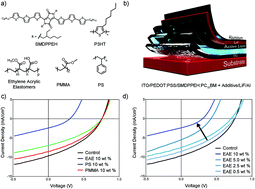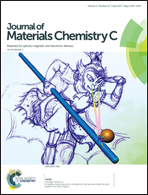Insulating polymer additives in small molecule and polymer photovoltaics: how they are tolerated and their use as potential interlayers†
Abstract
Additives are key to achieving optimal morphologies and efficient performance in bulk heterojunction organic photovoltaics. In this work we analyze the impact of three insulating polymers [ethylene acrylic elastomers, polystyrene and poly(methyl methacrylate)] in prototypical small molecule and polymer photovoltaic devices. We find that small molecule–semiconductors and polymer–semiconductors vary remarkably in their tolerance of the type of insulator as well as the degree of insulator incorporation. Insulating polymers capable of self-assembly or infiltration into the organic–semiconductor matrix have a positive or negligible impact on the performance of both small molecule and polymer devices. The spontaneous migration of ethylene acrylic elastomers to the device surface make them adverse additives, however our preliminary data indicates their potential application as a spontaneously forming cathode interlayer in small molecule devices where they match or exceed the performance of evaporated LiF interlayers.



 Please wait while we load your content...
Please wait while we load your content...